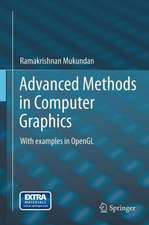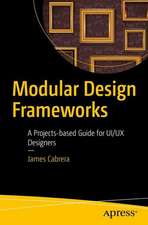Three-Dimensional Computer Vision: Symbolic Computation
Autor Yoshiaki Shiraien Limba Engleză Paperback – 11 ian 2012
Din seria Symbolic Computation
- 20%
 Preț: 350.21 lei
Preț: 350.21 lei - 20%
 Preț: 651.89 lei
Preț: 651.89 lei - 20%
 Preț: 647.61 lei
Preț: 647.61 lei - 20%
 Preț: 649.09 lei
Preț: 649.09 lei - 20%
 Preț: 648.44 lei
Preț: 648.44 lei - 20%
 Preț: 639.35 lei
Preț: 639.35 lei - 20%
 Preț: 653.06 lei
Preț: 653.06 lei - 20%
 Preț: 642.19 lei
Preț: 642.19 lei - 20%
 Preț: 651.09 lei
Preț: 651.09 lei - 20%
 Preț: 659.97 lei
Preț: 659.97 lei - 20%
 Preț: 645.31 lei
Preț: 645.31 lei - 20%
 Preț: 650.27 lei
Preț: 650.27 lei - 20%
 Preț: 646.47 lei
Preț: 646.47 lei -
 Preț: 394.29 lei
Preț: 394.29 lei - 20%
 Preț: 326.46 lei
Preț: 326.46 lei - 20%
 Preț: 342.28 lei
Preț: 342.28 lei - 20%
 Preț: 339.99 lei
Preț: 339.99 lei - 20%
 Preț: 641.01 lei
Preț: 641.01 lei - 20%
 Preț: 657.99 lei
Preț: 657.99 lei - 20%
 Preț: 648.26 lei
Preț: 648.26 lei - 20%
 Preț: 661.47 lei
Preț: 661.47 lei - 15%
 Preț: 638.89 lei
Preț: 638.89 lei - 20%
 Preț: 657.67 lei
Preț: 657.67 lei - 20%
 Preț: 652.73 lei
Preț: 652.73 lei - 20%
 Preț: 330.42 lei
Preț: 330.42 lei - 20%
 Preț: 709.98 lei
Preț: 709.98 lei - 20%
 Preț: 834.69 lei
Preț: 834.69 lei - 20%
 Preț: 656.03 lei
Preț: 656.03 lei - 20%
 Preț: 324.64 lei
Preț: 324.64 lei - 20%
 Preț: 757.48 lei
Preț: 757.48 lei - 20%
 Preț: 355.67 lei
Preț: 355.67 lei - 20%
 Preț: 328.27 lei
Preț: 328.27 lei - 20%
 Preț: 330.24 lei
Preț: 330.24 lei - 20%
 Preț: 342.96 lei
Preț: 342.96 lei - 20%
 Preț: 555.53 lei
Preț: 555.53 lei
Preț: 648.44 lei
Preț vechi: 810.55 lei
-20% Nou
Puncte Express: 973
Preț estimativ în valută:
124.09€ • 134.75$ • 104.24£
124.09€ • 134.75$ • 104.24£
Carte tipărită la comandă
Livrare economică 22 aprilie-06 mai
Preluare comenzi: 021 569.72.76
Specificații
ISBN-13: 9783642824319
ISBN-10: 3642824315
Pagini: 312
Ilustrații: XII, 298 p.
Dimensiuni: 170 x 244 x 16 mm
Greutate: 0.5 kg
Ediția:Softcover reprint of the original 1st ed. 1987
Editura: Springer Berlin, Heidelberg
Colecția Springer
Seriile Symbolic Computation, Computer Graphics - Systems and Applications
Locul publicării:Berlin, Heidelberg, Germany
ISBN-10: 3642824315
Pagini: 312
Ilustrații: XII, 298 p.
Dimensiuni: 170 x 244 x 16 mm
Greutate: 0.5 kg
Ediția:Softcover reprint of the original 1st ed. 1987
Editura: Springer Berlin, Heidelberg
Colecția Springer
Seriile Symbolic Computation, Computer Graphics - Systems and Applications
Locul publicării:Berlin, Heidelberg, Germany
Public țintă
ResearchCuprins
1 Introduction.- 1.1 Three-Dimensional Computer Vision.- 1.2 Related Fields.- 1.3 Mainstream of 3D Computer Vision Research.- 2 Image Input.- 2.1 Imaging Geometry.- 2.2 Image Input Devices.- 2.3 Color.- 2.4 Color Input.- 2.5 Range.- 2.6 Moiré Topography.- 2.7 Preprocessing.- 3 Image Feature Extraction.- 3.1 Edge Point Detection.- 3.2 Local Edge Linking.- 3.3 Edge Point Clustering in Parameter Space.- 3.4 Edge-Following Methods.- 3.5 Region Methods.- 4 Image Feature Description.- 4.1 Representation of Lines.- 4.2 Segmentation of a Sequence of Points.- 4.3 Fitting Line Equations.- 4.4 Conversion Between Lines and Regions.- 5 Interpretation of Line Drawings.- 5.1 Roberts’ Matching Method.- 5.2 Decomposition of Line Drawings Into Objects.- 5.3 Labeling Line Drawings.- 5.4 Further Problems in Line Drawing Interpretation.- 6 Realizability of Line Drawings.- 6.1 Line Drawings Without Interpretations.- 6.2 Use of Gradient Space.- 6.3 Use of Linear Equation Systems.- 7 Stereo Vision.- 7.1 Stereo Image Geometry.- 7.2 Area-Based Stereo.- 7.3 Feature-Based Stereo.- 8 Shape from Monocular Images.- 8.1 Shape from Shading.- 8.2 Use of Polarized Light.- 8.3 Shape from Geometrical Constraint on Scene.- 9 Range Data Processing.- 9.1 Range Data.- 9.2 Edge Point Detection Along a Stripe Image.- 9.3 Two-Dimensional Edge Operators for Range Images.- 9.4 Scene Segmentation Based on Stripe Image Analysis.- 9.5 Linking Three-Dimensional Edges.- 9.6 Three-Dimensional Region Growing.- 10 Three-Dimensional Description and Representation.- 10.1 Three-Dimensional Curves.- 10.2 Surfaces.- 10.3 Interpolation of Serial Sections with Surface Patches.- 10.4 Generalized Cylinders.- 10.5 Geometric Models.- 10.6 Extended Gaussian Image.- 11 Knowledge Representation and Use.- 11.1 Types of Knowledge.-11.2 Knowledge Representation.- 12 Image Analysis Using Knowledge About Scenes.- 12.1 Analysis of Intensity Images Using Knowledge About Polyhedral Objects.- 12.2 Analysis of Range Images with the Aid of a Junction Dictionary.- 13 Image Understanding Using Two-Dimensional Models.- 13.1 Recognition of Isolated Curved Objects Using a Graph Model.- 13.2 Interpretation of Imperfect Regions Using a Scene Model.- 13.3 Recognition of Multiple Objects Using 2D Object Models.- 14 Image Understanding Using Three-Dimensional Models.- 14.1 Matching for Verification Vision.- 14.2 Object Recognition by Predicting Image Features from Models.- 14.3 Matching Geometric Models to the Description of a Single Object.- 14.4 Recognition of Multiple Objects After Segmentation.- 14.5 Recognition Without Segmentation.- References.





















